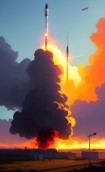|
iyaayas01 posted:
You need to be more specific. Did it start in FY08 or 2008?
|
|
|
|

|
| # ? May 25, 2024 02:27 |
|
Mazz posted:Something else to remember about the F-22; people always comment on its defensive stealth and overlook the APG-77 being probably the most capable radar ever put on an airplane that isn't the size of a 707. Does the integration of SAR mean that the F-22 and F-35 can replace the role of dedicated reconnaissance fighters/recon pods? Does the USAF even have reconnaissance aircraft aside from specialized U-2 and B-57 variants?
|
|
|
|
Suicide Watch posted:Does the integration of SAR mean that the F-22 and F-35 can replace the role of dedicated reconnaissance fighters/recon pods? Does the USAF even have reconnaissance aircraft aside from specialized U-2 and B-57 variants? Somewhere, far away from his loved ones, an RC-135 pilot gazes at the floor. A single tear rolls down his cheek.
|
|
|
|
GlassEye-Boy posted:Found these pictures of the NASA XC-142 online. Was this thing the precursor to the osprey? The Osprey's direct precursor was the Bell XV-15, which NASA played with for a few years from 1977 to the early 80s. When credible sport's failure resulted in the JVX program, 'enlarge the XV-15' was pretty much the easy mode route that they went with.
|
|
|
|
iyaayas01 posted:
Three years into being an administrative specialist, SGT Goon started to question his decision. Oh well, these leave forms aren't going to file themselves.
|
|
|
|
Nebakenezzer posted:Let me ask a question that fits into the previous topic seamlessly: how much do you love flying boats? I want you to know I appreciate this post, because the only thing cooler than a flying boat is a zepplin. On the other hand, html frames are bad, mmmkay?
|
|
|
|
CBJamo posted:I want you to know I appreciate this post, because the only thing cooler than a flying boat is a zepplin. Obviously we need to design a floatzeppelin (floppelin?) to create the ultimate aeronautical marvel. Godholio posted:In that timeframe, no, because computers aren't the only limiting factor. You've also got the radar's sweep rate and resolution cell, for example. Setting filters to zero, which is basically what we're talking about here, is going to completely white out your scope. You're going to see EVERYTHING that sends returns in your frequency band. That's going to include terrain, ground vehicles, buildings, possibly weather features, birds, RC planes, spurious bullshit that can't be correlated to anything.... This reminds me of the Swiss radars pinging cows on mountain slopes. http://inserbia.info/today/2015/03/switzerland-new-radar-confuses-cows-with-aircrafts/
|
|
|
|
Nebakenezzer posted:Let me ask a question that fits into the previous topic seamlessly: how much do you love flying boats? The account of the guy who runs it is "SA Ribbans" which one of you is this?
|
|
|
|
SybilVimes posted:I had become convinced that it was impossible to have a gullwing flying boat that was ugly...
|
|
|
|
How do the fancy-pants radars on F-22s/F-35s compare with the top-of-the-line Euro or Russian models? Mainstream news only talk about the stealth/LO stuff probably because it's way easier to explain. Can a Eurofighter (or whatever the fanciest non-US fighter is) do roughly the same things? I guess another way of framing the heart of my question: ignoring the LO entirely, how far ahead are the F-22/F-35 from the competition?
|
|
|
|
david_a posted:How do the fancy-pants radars on F-22s/F-35s compare with the top-of-the-line Euro or Russian models? Mainstream news only talk about the stealth/LO stuff probably because it's way easier to explain. Can a Eurofighter (or whatever the fanciest non-US fighter is) do roughly the same things? That's a hard question to answer because RADAR is one of those things you can't find much about other then basic details, especially newer systems. The Typhoon and Rafale both have AESA programs in the works, and one can assume the technology behind them is pretty on-par with US systems, and therefore the important parts are the software and stuff like the physical number of transmit/receive modules (more = better in most cases, AFAIK). Finding stuff out about the Russian systems is nebulous at best, but I'd assume they're good, but not at quite the same level as US systems because we've just always been better in this area. Same with the Chinese to an extent. When you look at the actual number of active AESA, the US is pretty far ahead as most other tacair examples are still in the testing or LRIP stages. There's way too much other poo poo to factor in to say that one player is definitely going to win a mock air war, but on a 1v1 basis the F-22 is still pretty god drat far ahead of anything else in the world if you're talking a unlimited ROE fight. The F-35 isn't really built to be a ASF, so it's not really comparable to the F-22 in that regard, but it should be pretty decent regardless since it's essentially a smaller APG-77 with more emphasis on ground tasks (that they've been slowly adding back to the F-22). Mazz fucked around with this message at 18:55 on May 13, 2015 |
|
|
|
EF doesn't even have an AESA yet. Rafale has had one for a year or so.
evil_bunnY fucked around with this message at 18:52 on May 13, 2015 |
|
|
|
I was just flipping through the thread, but when I saw that paragraph I knew it had to be iyaayas. Sadly I know what most of that means.
|
|
|
|
I'm guessing this a big fat No, but are there standards for these jet fighter data links? Like can a US plane share data real-time with a Rafale, Gripen, etc? In a joint operation like the Libya air strikes, do the planes from different countries operate as independent air forces or is there sharing of, uh, controller planes or whatever? How do they divide up the sorties?
|
|
|
|
david_a posted:I'm guessing this a big fat No, but are there standards for these jet fighter data links? Like can a US plane share data real-time with a Rafale, Gripen, etc? quote:In a joint operation like the Libya air strikes, do the planes from different countries operate as independent air forces or is there sharing of, uh, controller planes or whatever? How do they divide up the sorties? Also, there are actually multi-national AWACS aircraft: 
|
|
|
|
david_a posted:I'm guessing this a big fat No, but are there standards for these jet fighter data links? Like can a US plane share data real-time with a Rafale, Gripen, etc? Some of the fancy pants sharing is platform specific like merging a pair's radars. But in general, yes, we use standardized Link-16 links. Some aircraft can self report and pass their track data via link, others are picked up and reported by ground, surface, or aerial radars. Going in without a set kill chain with shared controllers is a nightmare, though there may be separate sectors where control is delegated or CAS stacks where JTACs or FAC(A)s take over. Links can be filtered to keep NOFORN or other non-NATO data off of NATO data links. Datalink connectivity is a really big reason why US and near-peer allies can stomp the poo poo out of nations with only slightly older hardware. Edit beaten. But technically the ACE is under the CFACC I thought with the deal that the CFACC will try not to take mission sets other than air defense, deep strike, and long range recce from the MAGTF, as well as "available sorties" mlmp08 fucked around with this message at 20:08 on May 13, 2015 |
|
|
|
NATO awacs is a sweetheart of an assignment.
|
|
|
|
Dead Reckoning posted:Actually, it's standardized within NATO as STANAG 5516, which is implemented as the Link-16 datalink. Not everyone is fully compatible yet, but I believe the Rafale, Gripen, and Typhoon all have it. Can Russian and Chinese planes talk to each other?
|
|
|
|
david_a posted:Can Russian and Chinese planes talk to each other?  Also, I hadn't noticed their names were written upside down until just now. Dead Reckoning fucked around with this message at 20:38 on May 13, 2015 |
|
|
|
Heh, I was just wondering since the Chinese seem to have a lot of Soviet/Russian planes and weird Chinese-built variations of them. But I guess they have no real need or desire to cooperate much.
|
|
|
|
evil_bunnY posted:EF doesn't even have an AESA yet. Rafale has had one for a year or so. I wonder if that contributes to the export sales the Rafale has scored in the last few months.
|
|
|
|
david_a posted:How do the fancy-pants radars on F-22s/F-35s compare with the top-of-the-line Euro or Russian models? Mainstream news only talk about the stealth/LO stuff probably because it's way easier to explain. Can a Eurofighter (or whatever the fanciest non-US fighter is) do roughly the same things? Eurofighter Typhoon: still using a mechanically scanned radar, the CAPTOR, derived from the good old Blue Vixen. To be replaced by the CAPTOR-E aka CAESAR (for Captor AESA Radar) at some point.Several versions of CAESAR are planned, IIRC, two using GaAs (one for partner nations, another for export) and later another using GaN (the UK wants this one). GaN (Gallium Nitride) is much better than GaAs (Gallium Arsenide) because it can withstand higher voltage and higher temperatures, so GaN modules can emit more power. And radars need a lot of power. If you look at the radar equation, you can see why you need to get all the power you can get if you want even meager gains in detection range. Rafale: Use the RBE2 radar. Older models are PESA; newer models (also called RBE2-AA) are AESA. All are using GaAs, though it's planned to update to GaN later. Note that Rafale already features some GaN emitters, but they're for the embedded electronic warfare suite, not for the radar. The Emirates want (or at least, wanted way back in 2011) an upgrade of the RBE2 with power output increased from 9.6 kW to 14 kW, meaning the range would be increased by about 10%; they might have dropped that requirement since the AESA version has increased range more than expected. (Apparently, the range for detecting a 1sq. meter target is 90 km for the PESA, and 160 for the AESA; back in 2011 they expected the AESA's range would only be about 140.) Gripen: Currently uses the Ericsson/GEC Marconi PS-05/A, a pulse doppler radar. It should be replaced by the Selex ES-05, an AESA radar, using GaAs transmitters. Currently, only the Rafale operationally uses an AESA radar (among the eurocanards). The other AESA radars promise to be more complex, with a repositionable swish plate for greater coverage. (And also because getting rid of movable parts would make maintenance guys sad.  ) )AFAIK the radars in the F-22 and F-35 are not the first GaN AESA radars developed in the USA, so that puts them at least at a two generation advantage over the European radars that are the first GaAs AESA radars they made. Radar size is also important, a larger aircraft can have a larger radar, and a larger radar will have more transmitter modules, making it more powerful. The GaN CAESAR, if it ever actually exists, would be the only one that's really close to the AN/APG-77; because the Rafale and Gripen are much smaller aircraft with a much smaller nose cone. That said, the long-term plans for the Rafale MLU is to replace or supplement the nose cone radar by conformal radars along the edge of the wings. That'd be interesting.
|
|
|
|
Anyone able to tell how the AN/APG-79 compares to the -77? Think Australia's getting them for the s-bugs. As an aside, I remember someone from saab talked about putting a split receiver aperture in the E further down the line. Take note that I have no idea what any of those words mean.
|
|
|
|
Dead Reckoning posted:
Mazz posted:That's a hard question to answer because RADAR is one of those things you can't find much about other then basic details, especially newer systems. The Typhoon and Rafale both have AESA programs in the works, and one can assume the technology behind them is pretty on-par with US systems, and therefore the important parts are the software and stuff like the physical number of transmit/receive modules (more = better in most cases, AFAIK). quote:There's way too much other poo poo to factor in to say that one player is definitely going to win a mock air war, but on a 1v1 basis the F-22 is still pretty god drat far ahead of anything else in the world if you're talking a unlimited ROE fight. The F-35 isn't really built to be a ASF, so it's not really comparable to the F-22 in that regard, but it should be pretty decent regardless since it's essentially a smaller APG-77 with more emphasis on ground tasks (that they've been slowly adding back to the F-22). Cat Mattress posted:AFAIK the radars in the F-22 and F-35 are not the first GaN AESA radars developed in the USA, so that puts them at least at a two generation advantage over the European radars that are the first GaAs AESA radars they made. Radar size is also important, a larger aircraft can have a larger radar, and a larger radar will have more transmitter modules, making it more powerful. The GaN CAESAR, if it ever actually exists, would be the only one that's really close to the AN/APG-77; because the Rafale and Gripen are much smaller aircraft with a much smaller nose cone.
|
|
|
|
Cat Mattress posted:Eurofighter Typhoon: still using a mechanically scanned radar, the CAPTOR, derived from the good old Blue Vixen. To be replaced by the CAPTOR-E aka CAESAR (for Captor AESA Radar) at some point.Several versions of CAESAR are planned, IIRC, two using GaAs (one for partner nations, another for export) and later another using GaN (the UK wants this one). GaN (Gallium Nitride) is much better than GaAs (Gallium Arsenide) because it can withstand higher voltage and higher temperatures, so GaN modules can emit more power. And radars need a lot of power. If you look at the radar equation, you can see why you need to get all the power you can get if you want even meager gains in detection range. I really appreciate the effort that went into coming up with the acronym CAESAR.
|
|
|
|
holocaust bloopers posted:I really appreciate the effort that went into coming up with the acronym CAESAR. I was just about to say that thats the high point of some engineer's career right there.
|
|
|
|
phongn posted:There is a place for them if you're building a complete national air-defense system on the scale of NORAD or PVO. Navweaps has a really nice summary of how IADS are designed; there's something of a follow-up to it with AWACS here (warning: super-conservative forum). Granted this is nationalistic chest thumping hearsay, but I remember some ex-RAF friends telling me a story about the typhoon radar/detection suite, which is supposed to be less bleeding edge compared to the US stuff. The US wanted to test it's stealth (don't remember if this story is supposed to be about the F-22, F-35, or if it's just some retold BS from the days of the F-117 or something with the names updated to modern relevance) and asked the Brits to try to spot their aircraft with their roughly peer-level radar, and the typhoon was able to spot it right away. Which lead to the US immediately demanding (and receiving) a typhoon to tear apart to figure out how they did it. Now, apart from sounding like complete and utter bollocks, it does lend credence to (and indeed was implied in the story I heard) the idea that while the hardware of the radar is certainly important, the data processing is what's really important, and can easily compensate for slightly less new hardware.
|
|
|
|
The JA 37 Viggen's radar had basically the same transmitter/receiver hardware from when it entered service in 1979 to when it was retired in 2004. The signal processing computers were upgraded in several stages though, and the software for them was continually modified and improved through the entire service life of the aircraft. By 2000, when the last modifications were done, the radar had basically double the detection range compared to its first incarnation. There had been some hardware mods with amplifiers of some kind installed, but most of it was in pure software. So yes, that stuff is really loving important. I've been working on a radar effortpost to go with the last part of the translation of the JA 37 seminar, but I'm lazy and have been researching other things as well, but I'll see about finishing it one of these days.
|
|
|
|
Linedance posted:Granted this is nationalistic chest thumping hearsay, but I remember some ex-RAF friends telling me a story about the typhoon radar/detection suite, which is supposed to be less bleeding edge compared to the US stuff. The US wanted to test it's stealth (don't remember if this story is supposed to be about the F-22, F-35, or if it's just some retold BS from the days of the F-117 or something with the names updated to modern relevance) and asked the Brits to try to spot their aircraft with their roughly peer-level radar, and the typhoon was able to spot it right away. Which lead to the US immediately demanding (and receiving) a typhoon to tear apart to figure out how they did it. There's also something to be said of modern IRST; a metal object at high speed is going to be hotter then the air around it, not to mention engine exhaust and other effects on the surrounding air, and these things are starting to get really good at detecting that heat from far, far away. The Eurocanards IIRC both have pretty solid IRST systems, and the Russians/Chinese have invested quite a bit into them. As a counter, I'm pretty sure most of the planes in this discussion also take steps to mask that IR signature at least somewhat. It's very hard to ever say something definite though because every nation in this discussion goes about as far as they possibly can to not have this poo poo known. EDIT: After reading it again I question whether this actually happened with a Typhoon because I doubt the UK would hand one over so easily when they paid out the rear end for them. Mazz fucked around with this message at 02:01 on May 14, 2015 |
|
|
|
With the Link-16 data link stuff, does that get taken out for planes sold to non-NATO nations? IE could a Thai Gripen talk to a Saudi Typhoon?
|
|
|
|
david_a posted:With the Link-16 data link stuff, does that get taken out for planes sold to non-NATO nations? IE could a Thai Gripen talk to a Saudi Typhoon? IF they have the same crypto loaded...
|
|
|
|
Dead Reckoning posted:Somewhere, far away from his loved ones, an RC-135 pilot gazes at the floor. A single tear rolls down his cheek. Also everyone at Creech hannibal posted:I was just flipping through the thread, but when I saw that paragraph I knew it had to be iyaayas. Sadly I know what most of that means. Yay acquisitions!!! Dead Reckoning posted:Actually, it's standardized within NATO as STANAG 5516, which is implemented as the Link-16 datalink. Not everyone is fully compatible yet, but I believe the Rafale, Gripen, and Typhoon all have it. So now that we've answered doctrine, let's talk about how things actually worked during, say, OUP. (  ) )Dead Reckoning posted:Also, there are actually multi-national AWACS aircraft: And every ABM (or anyone else on US AWACS) would give their left nut to go to GK Speaking of which, hey Godholio, I know an ABM who dropped GK straight out of school. Mazz posted:EDIT: After reading it again I question whether this actually happened with a Typhoon because I doubt the UK would hand one over so easily when they paid out the rear end for them. As long as the "tearing apart" was ultimately non-destructive so they got it back in one piece (and as long as they had an opportunity to remove any "Brit only" bits and pieces) I'm sure they would've handed it over on request. There's a price to being in FVEY and the Brits are more than willing to pay that. CommieGIR posted:IF they have the same crypto loaded... And therein lies the rub
|
|
|
|
david_a posted:With the Link-16 data link stuff, does that get taken out for planes sold to non-NATO nations? IE could a Thai Gripen talk to a Saudi Typhoon? Link-16 is almost entirely unclassified and very widespread, so it would probably just be a question of whether those operators wanted to buy that equipment with their planes. Like CommieGIR said, it's really the crypto load where you get your security. The waveform, architecture, message format, and all that stuff are openly available (Northrup Grumman publishes a sweet-rear end guide book that describes it all pretty well).
|
|
|
|
^You can easily think of it like any other radio system. Sure, you can predict how the wave is going to function, how to transmit and receive on the appropriate frequency, but if it's secured properly you're just going to hear poo poo. With systems like Link 16 it gets even more complicated because it's frequency-hopping. That adds a lot of variables.Linedance posted:Granted this is nationalistic chest thumping hearsay, but I remember some ex-RAF friends telling me a story about the typhoon radar/detection suite, which is supposed to be less bleeding edge compared to the US stuff. The US wanted to test it's stealth (don't remember if this story is supposed to be about the F-22, F-35, or if it's just some retold BS from the days of the F-117 or something with the names updated to modern relevance) and asked the Brits to try to spot their aircraft with their roughly peer-level radar, and the typhoon was able to spot it right away. Which lead to the US immediately demanding (and receiving) a typhoon to tear apart to figure out how they did it. Bunk. They wouldn't have had to go through all those steps. There are RAF pilots that are F-22 qualified, for fucks sake. The CAPTOR-E is probably comparable to the APG-63v3 or APG-79. Which means that no, it's generally not going to see a Raptor at ranges that will save it's life. Tactical control of multinational assets: Not that complicated. It depends on the nature of the scenario, but for example in Iraq and Afghanistan, USAF E-3s controlled coalition aircraft every time they flew. Likewise, when NATO AWACS finally got their paperwork sorted after about two years of trying, if they had the airspace they controlled US aircraft. No big deal. It all runs through the CAOC. Edit: Word has been spreading for the past 4 or 5 years that GK is no longer a garden assignment. At least not to the degree it used to be...it's still a thousand times better than Tinker, but Elmo and Kadena are in higher demand. Godholio fucked around with this message at 07:11 on May 14, 2015 |
|
|
|
I've been lucky enough to be holidaying on the island of Santorini off the coast of Greece this week, which has a surprisingly large airport. Plane related highlights so far have included seeing some Herc landings as well as spotting the carcass of what looks like an old abandoned F-4 in a corner of the airfield, but the other day I could have sworn an A10 flew overhead, admittedly at a pretty high altitude so I could be mistaken. Is it possible that this is what I saw? Are squadrons of these even based in Europe these days?
|
|
|
|
Godholio posted:it's still a thousand times better than Tinker, but Elmo and Kadena are in higher demand. Why would Elmo be in demand? I mean, I'm no mil dude nor do I have a beef with Alaska (hell I'm just down the "street") but that seems boring? Or maybe not what with fun times to be had loving with Russia?  vvvvv gawdamn Duke Chin fucked around with this message at 14:12 on May 14, 2015 |
|
|
|
|
|
|
|
atomicthumbs posted:Badass B-1 Picture One of my favorite aviation memories is from the first or second (cant remember) Fort Lauderdale Air and Sea show on Lauderdale beach... I was floating in the water with my ears just under the surface, and a B-1 came over show center from right to left with the wings tucked back, all four engines at full burner, at mach .9997 or so. The OCEAN shook. It was loving amazing in every way. It's also the only time I've ever seen a B-1. Also, that was an awesome place for an airshow, with the exception of parking and transport. Sitting on the beach with a beer in your hand, watching the Blue Angels is pretty much heaven.
|
|
|
|
Hhhhhnnnnnngggg
|
|
|
|

|
| # ? May 25, 2024 02:27 |
|
MrYenko posted:B-1 stuff We have B-1s come by Amarillo occasionally from Dyuss AFB. I have to hope nobody tries to talk to me when they put the burners on because I can't hear poo poo and the whole tower shakes. We don't have noise restrictions at all, they come by 15 minutes before midnight and make a bunch of noise. Then we get calls from the cops that people are worried/pissed about the loud airplanes.
|
|
|











































